Lampedusa: of turtles and men
The objective of our July field mission was simple: return to Lampedusa to work with the team at the center for marine turtles led by Daniela Freggi. We are starting to be quite familiar with this unique place. It’s a small rock where several large worlds collide. Europe, Africa, human migrations, geopolitics, tourism, fishing zones, and of course the large population of sea turtles that live in the warm waters of the region.
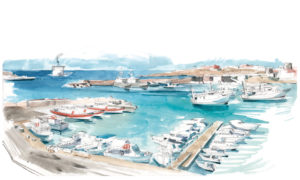 In the middle of this boiling pot, Daniela, a woman of great righteousness and exceptional courage who chose to dedicate her life to sea turtles caught by accident by local fishermen. Even if it is “a drop in the ocean” as she likes to say, Daniela is the living proof that humanity is not just a mere concept.
In the middle of this boiling pot, Daniela, a woman of great righteousness and exceptional courage who chose to dedicate her life to sea turtles caught by accident by local fishermen. Even if it is “a drop in the ocean” as she likes to say, Daniela is the living proof that humanity is not just a mere concept.
This new field mission is crucial to the Octopus Foundation team for two main reasons. Firstly, we need adult turtles in the open sea to test the first prototype of our REMORA beacon. This retrievable camera is being developed for biologists who study Mediterranean sea turtles. Secondly, we will follow local fishermen to show the reality of these men of the sea who accidentally capture turtles. Fishing gear such as longlines are set for several hours to target tuna and swordfish, but marine reptiles are part of the unintentional bycatch. It seems very important to us to talk about this subject, and the fact that some fishermen have understood the importance of saving turtles to help this fragile marine ecosystem.
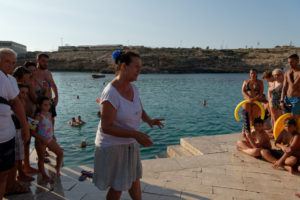
No more lab testing
We decided to begin by attaching a REMORA on the back of a 50 kg turtle for nearly 12 hours. With an animal of this size and weight, it’s not unreasonable to expect the small electronic device to have to dive to 40 or 50 meters deep, and travel several kilometers away from the island of Lampedusa.
Despite everything, we remained confident. After all, REMORA01 had already worked very well in June in the Argostoli lagoon in Kefalonia. The next big step for our R&D was to try the experiment in the open sea here in Lampedusa. Of course, we kept in mind that we had found a little bit of water in the housing of REMORA01 after 24 hours in the lagoon… Despite this, the device had worked perfectly. Also, the 10 days separating the two missions of June in Greece and July in Italy did not allow us to consider extensive testing and major technical modifications.
1st test with SunFlower
Two days after our arrival in Lampedusa, the weather was favorable, so we installed the REMORA01 on the back of “SunFlower”, a magnificent 50 kg female turtle. It only took her a few minutes to get out of “Cala Madone”, thanks to her disconcerting swimming power. Then began the nail-biting wait. REMORA01 was set up to remain silent until around 5:00 p.m., when the beacon had to detach itself from the turtle, float back to the surface and transmit to us the first ARGOS positions.
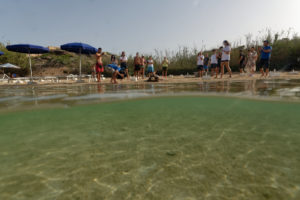 At the appointed time, we were waiting in our rigid inflatable motorboat docked at the port. Ready to leave quickly in the direction of the ARGOS position. But the transmission never came. Against all odds, and to confirm our bad feeling, we still went out and scanned the sea several times with our LoRa antenna, designed to receive the prototype’s position. Unfortunately, we found nothing but silence.
At the appointed time, we were waiting in our rigid inflatable motorboat docked at the port. Ready to leave quickly in the direction of the ARGOS position. But the transmission never came. Against all odds, and to confirm our bad feeling, we still went out and scanned the sea several times with our LoRa antenna, designed to receive the prototype’s position. Unfortunately, we found nothing but silence.
At this stage, we believed that a technical incident had occurred with the REMORA01. This was the device we had tested in Greece a few weeks ago. The one whose components had perhaps been damaged by seawater corrosion. At this stage, we did not think that this was a problem that could affect all of our beacons. Why would the system have worked in Greece in June and not in Italy in July?
2nd test with SunRise
This mistake prevented us to avoid the same painful experience the next day, with REMORA02 on the back of “SunRise”, another female who had been rescued at the center. This new device was thoroughly tested, retested, the batteries fully charged. At the end of 11 hours, the silence from the ARGOS platform and our LoRa receiver could not be mistaken. All that remained was the sea and the waves, as far as the eye could see. Despite the frustration, we had the comfort of knowing that the tags were no longer on the turtles’ backs and that the wild animals were now swimming freely in the open sea, probably happy to have returned to their natural environment.
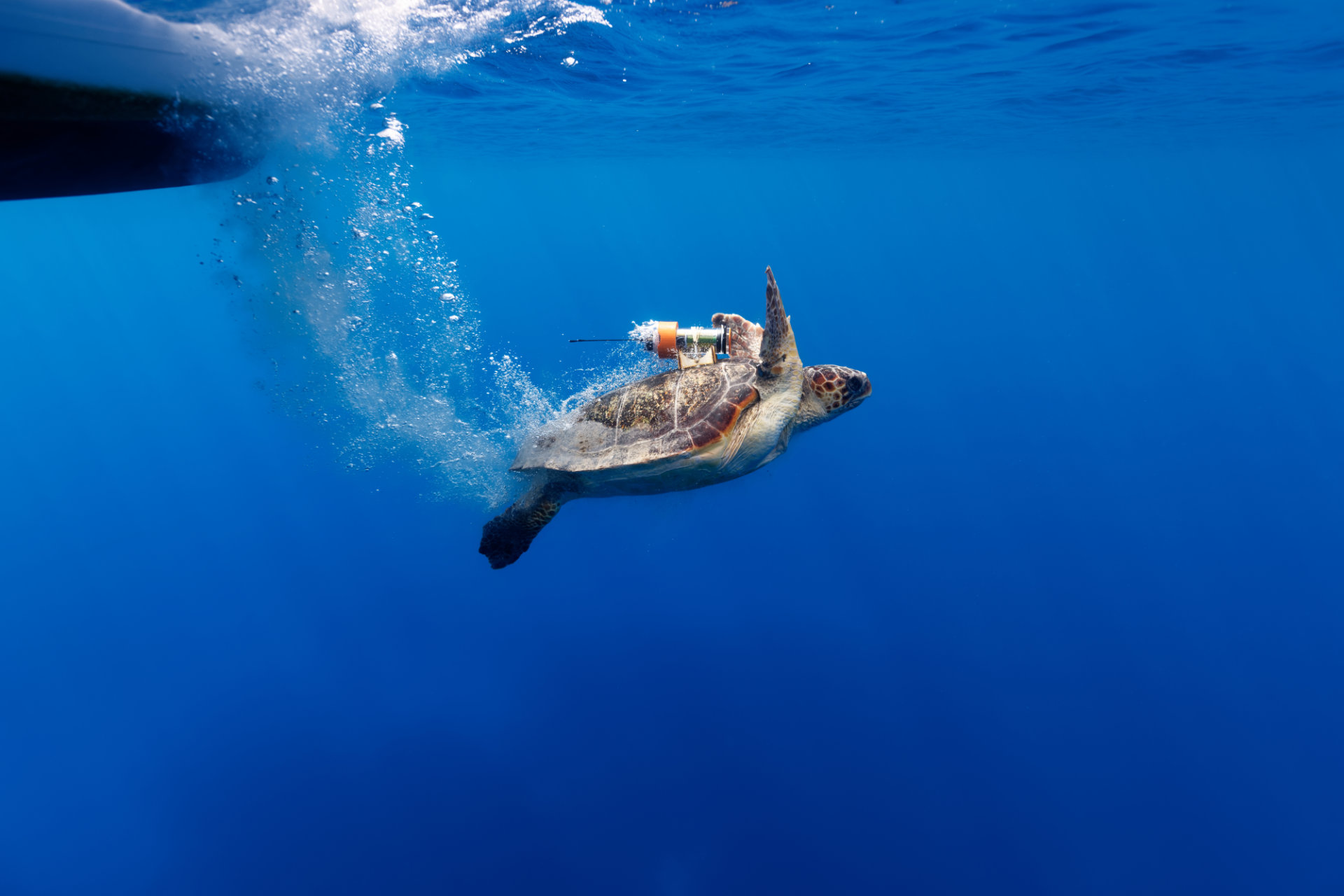
This first REMORA prototype was developed in record time, and it had already delivered incredible results in June. In Lampedusa, with the loss of two devices in two days, we had to admit that there was a fatal problem. Yet, it is in adverse situations that a team needs to work together to come out victorious. We regrouped, to identify the problems, and correct the errors. The whole question was to know if there was only one factor of error or if, as is often the case at sea, several elements had added up?
Learn from your mistakes
As a problem never comes alone, Lampedusa was hit by a heat wave of more than 40°C which was expected to last three days. It was so hot that a thick layer of fog covered the island at the first lights of dawn. We were forced to change our way of working, to make our brains function in unfavorable conditions. Later, our group was separated because the fisherman had just given the green light so that two of us could follow him the next day at 5:00 a.m. Philippe and Thomas, dedicated more specifically to the video documentary, were going to leave with the fisherman. Quentin, Séb, Antoine and Julien were going to stay on land to try to understand what had happened with the REMORA01 and REMORA02, in order to modify our last prototype, the REMORA03.
 After several hours of breaking down the chain of events since our mission in Greece, and of precisely studying the different components of the last prototype still in our possession, we began to identify the weak point. One of the caps of the tube serving as a waterproof housing had to be printed in 3D to accommodate five different components: two antennas, a pressure sensor, a USB plug and a small air valve to test the waterproofing of the housing. A real puzzle where every tenth of a millimeter is essential for all the pieces to fit together perfectly. And yet, Quentin solved this micro-puzzle in his workshop in Rennes. Unfortunately, and despite the very high precision of 3D printing, the seal was not as good as the original cap, made of a piece of aluminum and a thick plate of Plexiglas.
After several hours of breaking down the chain of events since our mission in Greece, and of precisely studying the different components of the last prototype still in our possession, we began to identify the weak point. One of the caps of the tube serving as a waterproof housing had to be printed in 3D to accommodate five different components: two antennas, a pressure sensor, a USB plug and a small air valve to test the waterproofing of the housing. A real puzzle where every tenth of a millimeter is essential for all the pieces to fit together perfectly. And yet, Quentin solved this micro-puzzle in his workshop in Rennes. Unfortunately, and despite the very high precision of 3D printing, the seal was not as good as the original cap, made of a piece of aluminum and a thick plate of Plexiglas.
We also concluded that it was necessary to limit the number of holes to be drilled, thus limiting the risks of water leakage. At a minimum, the REMORA needs two communication antennas (ARGOS and LoRA) so that we can find and recover it, as well as the pressure sensor to record the turtle’s diving profiles. All that remained was to dismantle everything, and perfectly drill in suffocating heat these three holes in a 6 mm thick plexiglass plate… without a precision machine at our disposal.
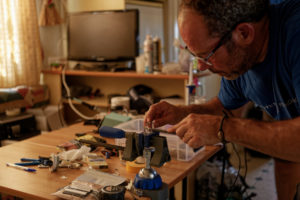
A challenging and satisfying day
But it is in these difficult conditions, where it is clearly easier to doubt, that the Octopus Foundation team excels. At 5:00 a.m., Thomas and Philippe boarded the fishing boat with their diving and filming equipment. 9:00 a.m., we assessed the condition of the REMORA. 11:00 a.m., Quentin and Sébastien drew up a plan of the modifications to be made. 2:00 p.m., Sébastien had organized a makeshift workshop in a mobile home, and carried out with impressive precision the holes and the sealing of the three elements fixed in the Plexiglas plate. During this time, Quentin made the necessary modifications to the body of the REMORA. At the same time he developped a small device capable of recording the pressure variation inside the tube… 6:00 p.m., the different elements were reassembled. 8:00 p.m., the REMORA03 was ready for testing.
To top off this crazy day, we met up with Thomas and Philippe who were returning from their day aboard the fishing boat. Everything had gone extremely well for them. They were able to film the recovery of two turtles accidentally caught on the hooks of the fishing gear. For the first turtle, they chose to film the recovery operations by drone and from the boat to show how the fishermen took care of the captured reptiles to bring them back to the center run by Daniela. For the second animal, they went into the water with their diving equipment to show the operation from below. They returned exhausted but happy to have been able to shoot this precious testimony in images.
The team being complete again, the objective was now to go out at sea to test our modified prototype, taking care to avoid cutting corners. We were first going to take a day to test the waterproofing of the device at different depths, without electronics. Secondly, we were going to consider a test on the last turtle in the center which was to be released.
Last minute fine tuning
It was finally on the day of departure that we were able to follow this last turtle equipped with the REMORA03. Based on what had happened earlier, we decided to only leave our prototype for 40 minutes on the animal. At the end of the test, we recovered the device and let the turtle go into the deep blue of the Mediterranean.
The camera and sensors worked perfectly. The waterproofing was good… except that once back at the surface, the ARGOS communication module was unable to transmit its position back at us. As said before, it’s rarely a single problem but more often a combination of several.
 We therefore left Lampedusa to head home with the REMORA03 in our luggage, keeping in mind that discovering the world of turtles offshore would prove to be more complex than we imagined. But we were only at the beginning of this exciting adventure!
We therefore left Lampedusa to head home with the REMORA03 in our luggage, keeping in mind that discovering the world of turtles offshore would prove to be more complex than we imagined. But we were only at the beginning of this exciting adventure!
